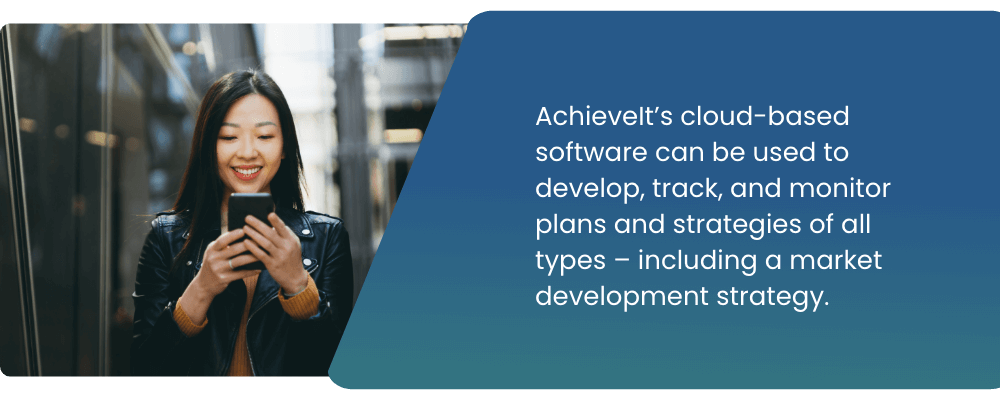Companies focus on market strategy development and execution when looking to expand their total addressable market or market a new use for an existing product. Knowing your market is just as important as knowing your organization. It is important for growing businesses to draft a compelling market development strategy, as part of a comprehensive strategy development and execution process, and to create goals and objectives to implement the strategy so that company growth and revenue do not stagnate.

Target Customer & Reasons to Buy
The Chasm Institute recommends a nine-element approach to creating a market strategy development and execution. Here, we delve into two of the most important elements: target customers and reasons to buy.
Target Customer: It is important to identify the target customer first because they are the direct source of revenue. Without identifying the source of revenue, the rest of the strategy cannot move forward. It is common for most businesses to have more than one target customer. Try to think of as many viable target customers as you can.
Reasons to Buy: New enterprises often begin because an entrepreneur saw a gap in the market and a demand for the product. Other times, savvy business executives have to create a need for a product they feel passionately about, thus the need for a market development strategy. Once you have identified your target customer, write down compelling reasons they should buy the product. These could include core business processes or issues the product solves or assisting the business in generating better value or production quality.

What is a Market Development Strategy?
A market development strategy is designed to help companies move new products into the marketplace, expand their existing reach, or expand the use of their current products to do new things. It’s essentially a miniature strategic plan because it has all the same elements as a strategic plan: goals, objectives, strategies, and tactics. We assign tactics to people in our organization, we hold people accountable, and we drive as fast and hard as we can. If you do these things, you will find your market development strategy moves a little bit smoother and a little bit faster.
What’s the Key to Market Development Strategy?
The key to a market development strategy is the understanding of the current baseline performance vs. what we want our future performance to be, and then coming up with the strategy to move from A to B. The strategy revolves around geography, customer base, and products.
Market Strategy Development Components
There are three different areas we talk about when discussing market development strategy:
- Geography: We want to expand our footprint by expanding our product into new markets where we currently don’t exist.
- Customer Base: We want to expand the customer base; maybe right now we are focused on middle-aged adults, or seniors, or kids, or teenagers, but we want to move into a new customer segment to expand the sales of our current offerings.
- Products: This includes both new and existing products. How do we take our existing products and do things with them that push them to other customer bases or geographic segments? How do we identify what are the customer needs, and use that knowledge to make new products or services that we can then bring to market?
Market Strategy Development Examples
Regardless of what kind of organization or company you have, you will generally deal with these three spheres of influence.
Example #1 – Hospitals
If you are a hospital, your geographic strategy may be around the placement of clinics in secondary and tertiary markets.
Expanding your customer base may include an expansion into pediatrics; maybe you have never really treated pediatrics and now you are going to open a whole pediatric unit.
In terms of new products, perhaps you are not doing cardiovascular medicine, and you are going to start an open heart program to drive cardiovascular medicine into your organization.
Example #2 – Cereal Manufacturer
If you are a cereal manufacturer, you have to deal with distribution issues around geography.
Your customer base is largely about product positioning; perhaps we need to offer healthy cereal alternatives to attract a new customer segment or create an organic version of our products.
Example #3 – Banks
If you are a bank, we can use this same model.
Geography may be around the location of branches.
Our customer base includes people needing mortgage financing, which will enable us to expand to customers who want to become homeowners.
Additionally, we may have investment products we want to bring to the marketplace to help grow the organization.
Regardless of what industry you are in, there is one common denominator among all industries. Everything I just described was a measurable objective. Looking at growth in the secondary or tertiary markets, increasing the number of mortgages that we are writing, or increasing product distribution through our cereal company – those are all measurable. They are all objectives we can put numbers on that provide us with a baseline and a target.

Market Strategy Development and Execution: Other Considerations
The Chasm Institute also includes these four important elements in its model:
- Whole Product: If your business sells only one product, write that product down. This is your “whole” product. If you are a business that has multiple products, then you should think of ways and reasons to sell as many products to your target customer as possible. The “whole product” should be a bundle of all the products and services you are aiming to sell to each target customer.
- Distribution: How will you get your product to market? The distribution element identifies which markets and venues will be best for sales, and which vendors and companies are your “allies” when it comes to getting your product to target customers. Will you use direct or indirect sales? How much interaction will you have with each target customer?
- Competition: Identifying your competition is also important when drafting distribution ideas for your market development strategy. You should write who is your most direct competition with each target customer, but not make them the sole focus. You need to be aware of competitors in your industry, but your main objective should never be to “beat the competition.”
- Positioning: It is important to identify competition because then you have a better idea of how to present your product to the target customer. Why is your product the better choice? What advantages can your product give over the others? Product positioning should aim to answer the question: “What makes you different?”
How AchieveIt Aids in Market Strategy Development and Execution
AchieveIt’s cloud-based software can be used to develop, track, and monitor plans and strategies of all types – including a market development strategy. It includes a suite of tools that allow organizations to gather strategic business intelligence to focus its strategy, flexible plan design templates to build results- and action-oriented strategies, the ability to cascade assignments to individuals, automatic plan ROI calculations, scorecards, and dashboards, and point-and-click reporting.
This best-of-breed software guides you through AchieveIt’s proven Execution Flywheel that has generated breakthrough results for clients. No other cloud-based application guides you through the entire strategy development and execution management life cycle with such focused precision.

About AchieveIt
AchieveIt is the platform that large organizations use to get their biggest, most important initiatives out of the boardroom and into reality. Too many great ideas never quite make it across the finish line, because there’s no real way to keep everyone on course and keep everything on track. What does it take to actually guide these initiatives all the way through to completion? You’ve got to:
- Get everything in view – so you can see what’s happening with every initiative, at every level, from the enterprise to the individual, in real-time.
- Get everyone engaged – with an easy-to-use platform that connects your organization from the executive leadership to the project teams, keeping everyone accountable and on the same page.
- Get every possible advantage – not only because you have the premier platform in this space, but because you can draw on the experience and best practices of our execution experts.
That’s why everyone from global corporations, to regional healthcare systems, to federal agencies has turned to AchieveIt for their Integrated Plan Management. Let’s actually do this.



